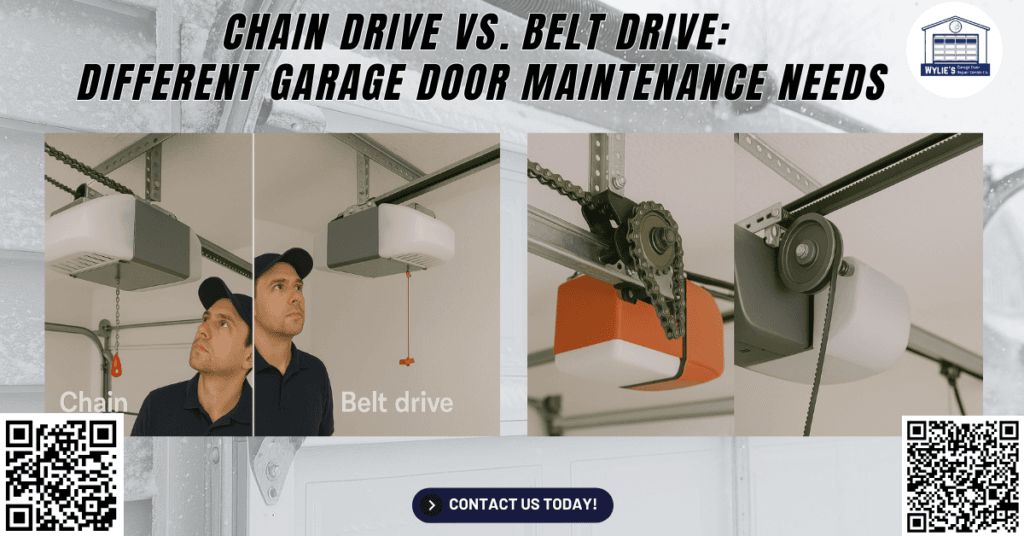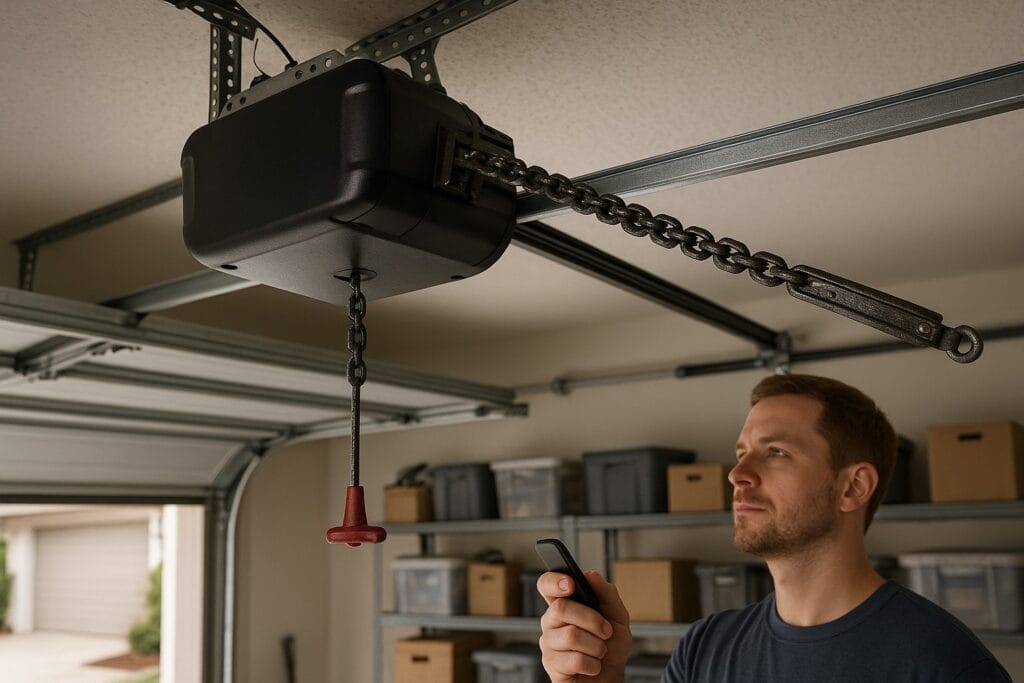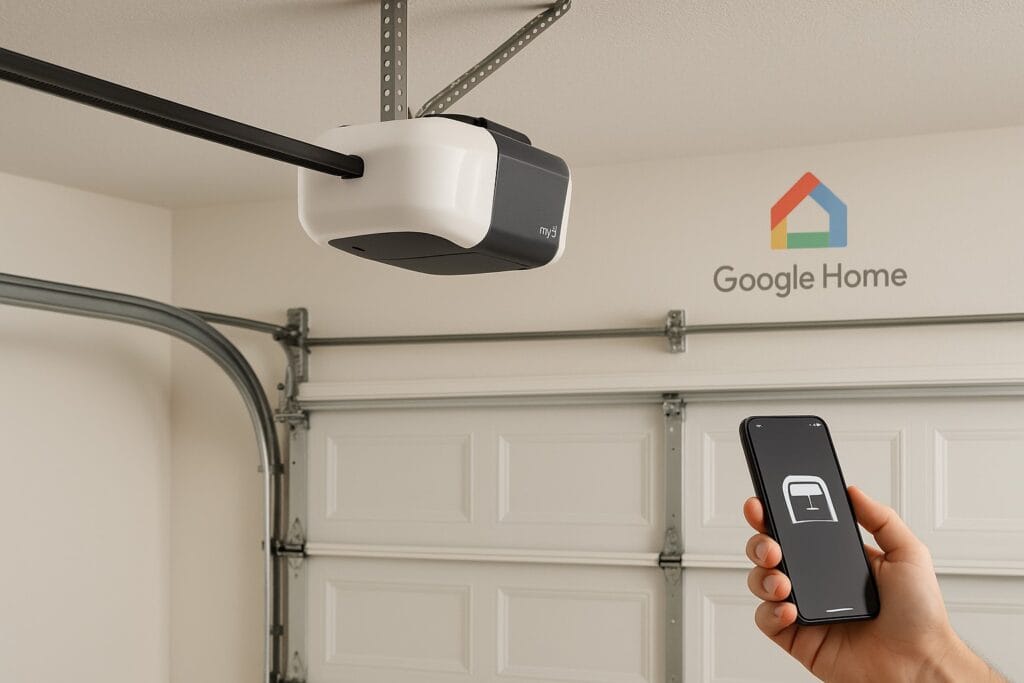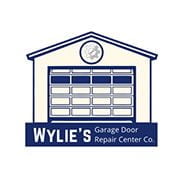Chain Drive vs. Belt Drive: Different Garage Door Maintenance Needs

The Real Cost of Neglecting Garage Door Maintenance
Not long ago, a homeowner in Wylie, TX reached out to us at Wylie’s Garage Door Repair Center Co. with an urgent issue: their garage door had stopped working right before they had to leave for an important family event. Upon inspection, our trained technician discovered that the chain drive had rusted over, the sprockets had worn down, and the garage door rollers were out of alignment due to long-overdue maintenance. A quick service call, application of white lithium grease, and a few component replacements saved the day, but it could have been avoided with regular garage door maintenance.
According to the Family Handyman and other industry experts, garage doors are often the most-used entry point in modern homes, opening and closing multiple times a day. Yet, they are also the most neglected. The importance of regular maintenance cannot be overstated: it ensures quiet operation, prevents unexpected breakdowns, and extends the lifespan of your garage door opener, rollers, springs, cables, and hinges. Well-maintained systems are also more energy-efficient, safer for families, and less likely to suffer from water or weather-related damage.
Whether you have a chain drive or a belt drive system, understanding the different garage door maintenance tasks required for each type is crucial for homeowners who want smooth operation, safety, and value. This guide from Wylie’s Garage Door Repair Center Co. breaks down the steps, tools, and tips for keeping your system running flawlessly, year after year.
Chain Drive vs. Belt Drive: The Basics
Before diving into maintenance requirements, it’s essential to understand what separates these two garage door opener types.
Chain Drive Garage Door Openers
Chain drive systems use a metal chain (similar to a bike chain) that connects to a motor. The motor moves the chain, which pulls a trolley connected to the garage door’s arm bar. These systems are built for strength and durability, ideal for lifting heavy garage doors, including solid wood doors or doors reinforced with steel. Because of their rugged design, they are often preferred for detached garages or commercial buildings.
- Pros: Affordable, strong, widely available, suitable for heavier doors
- Cons: Noisier, requires more frequent lubrication and adjustment, can be affected by rust and weather conditions
Belt Drive Garage Door Openers
Belt drive systems use a rubber or polyurethane belt reinforced with fiberglass or steel cords to move the trolley. These systems are known for their quiet operation and are often paired with smart features like Wi-Fi connectivity, battery backup systems, and soft start/stop technology. They are ideal for attached garages where noise reduction is a top priority.
- Pros: Whisper-quiet, smooth motion, fewer vibrations, modern features available
- Cons: More expensive, belts may wear down over time, less suitable for extremely heavy doors
Understanding your garage door system is the first step in effective, preventative maintenance. Choosing the right system for your home or commercial property can make all the difference in long-term durability and comfort.
Chain Drive Maintenance: Strong But Needy
Chain drive systems are workhorses but need consistent attention to ensure optimal function.

1. Lubricate the Chain and Moving Parts
Use a white lithium grease or garage door-specific spray lubricant to coat the chain, top rail, roller brackets, and other metal parts. This reduces friction, prevents rust, and ensures quieter operation. Over time, dust and dirt can accumulate on unlubricated parts, accelerating wear and tear.
Tip: Do this every six months, or more frequently if your garage is exposed to extreme weather or high usage. Always clean old grease and debris before reapplying lubricant.
2. Check Chain Tension
Improper chain tension can lead to excessive noise or system strain. A sagging chain needs tightening, while an overly tight chain can damage the drive and motor. Chain tension also affects door alignment, potentially causing uneven movement or grinding sounds.
Step-by-Step Guide:
- Disconnect the automatic opener using the release handle.
- Adjust the tension bolt on the chain mechanism.
- Reconnect the opener and test the door’s movement.
- Listen for unusual noises during operation.
3. Inspect for Rust and Corrosion
Look for rust spots along the chain, sprockets, and metal brackets. Use a wire brush to clean affected areas, then reapply lubricant. Corrosion can compromise the structural integrity of the drive system.
Pro Tip: In humid environments or during seasonal shifts, check for rust monthly. Applying a rust-resistant sealant can extend component life.
4. Clean Tracks and Rollers
Remove debris, dust, and old grease from the tracks using a vacuum or a damp cloth. Inspect garage door rollers for cracks or flattening, especially nylon rollers. Steel rollers should be lubricated, while nylon ones should only have lubricated bearings. Dirty or damaged rollers can cause the door to shake or get stuck.
Family Safety Note: Always ensure the garage door is disconnected from power before cleaning tracks. Use gloves and eye protection when cleaning with sprays or solvents.
Belt Drive Maintenance: Sleek but Sensitive
Belt drives require less maintenance but are sensitive to weather changes and wear over time.

1. Inspect the Belt for Cracks and Frays
Look for signs of wear, such as stretching, tearing, or separation in the belt. Replace the belt if any damage is evident. A damaged belt may slip, causing improper door operation or sudden failure.
Inspection Tip: Perform this task twice a year or before extreme seasons like Texas summers or winters. Also, inspect the belt pulley and connection points for wear.
2. Adjust Belt Tension Carefully
Use your opener’s manual or call a professional to ensure belt tension is optimal. An overtightened belt can cause the motor to strain, while a loose belt may slip or derail. Modern systems often include auto-tensioning features that help maintain correct tension.
First Step: Always unplug the garage door opener before attempting adjustments. Use a socket wrench to access tension bolts.
3. Clean the Top Rail and Trolley
Unlike chain drives, belt systems do not require greasing the belt. Instead, keep the rail and trolley free from debris and dust. Use a microfiber cloth or light spray cleaner to maintain a clean, obstruction-free path.
Maintenance Tasks:
- Wipe rails clean every 4-6 months.
- Check the arm bar connection for stability.
- Ensure the door balances properly with the opener disengaged.
- Inspect rail for bending or damage.
4. Monitor for Noise and Vibration
A belt drive should operate nearly silently. If you hear grinding, popping, or rattling, it’s time to inspect the system. Sometimes noise is caused by loose bolts or misaligned parts.
Contact Wylie’s Garage Door Repair Center Co. immediately if your belt drive is no longer whisper-quiet. Early intervention can prevent expensive repairs.
Shared Garage Door Maintenance Essentials
Both chain and belt systems have overlapping maintenance needs. Ignoring these basic tasks could lead to damage, safety risks, or costly repairs.
1. Test the Auto-Reverse Feature
Place a block (like a 2×4) in the door’s path. Close the door using the remote or wall panel. If the door doesn’t reverse upon contact, the auto-reverse safety feature may be malfunctioning. This is essential for preventing accidents or injuries.
2. Sensor Alignment and Cleaning
Photo-eye sensors should be aligned and clean for the door to function safely. Use a clean cloth to wipe them and check alignment visually. Misaligned sensors are a common cause of door failure.
Common Problem: Cobwebs or dirt can block the beam, causing the system to malfunction. Use a vacuum or gentle brush to keep sensors free of debris.
3. Tighten Bolts, Hinges, and Roller Brackets
Using a socket wrench, inspect all nuts, bolts, and screws on the door panels, tracks, and opener system. This should be done quarterly. Loose hardware causes unnecessary wear and misalignment.
Garage Door Tip: Loose hinges and brackets are leading causes of door misalignment and loud operation. Also, check for stripped threads or missing bolts.
4. Examine Garage Door Springs and Cables
Torsion springs and extension springs should be free from rust, separation, or slack. Cables should not be frayed or worn. Worn springs or cables can cause serious operational hazards.
Safety Warning: Never attempt spring repairs yourself. These parts are under extreme tension and can cause injury. Call a professional technician.
5. Clean and Replace Weatherstripping
Inspect the seal at the bottom of the garage door and along the sides. Damaged weatherstripping allows in moisture, pests, and drafts. Over time, it can lead to water damage and rust.
DIY Guide:
- Remove old weather stripping using a utility knife.
- Clean surface and apply new stripping using adhesive or screws.
- Test for an airtight closure.
- Check annually or after major storms.
Weather and Seasonal Maintenance in Wylie, TX
Wylie, TX, sees hot summers, wet springs, and occasional cold snaps; each season presents unique challenges to garage door systems.
Spring & Summer
- Clean tracks of mud and pollen
- Apply garage door lubricant to metal parts
- Check sensors and auto-reverse functions
- Inspect cables for humidity damage
- Replace worn weather stripping to prevent insect intrusion
Fall & Winter
- Inspect belts and springs for cold-related contraction
- Re-grease moving parts
- Examine power connections and remote batteries
- Check for ice buildup on tracks or rollers
- Lubricate hinges, bearings, and moving parts more frequently
Pro Tip: Schedule bi-annual professional inspections in spring and fall to catch issues early and avoid winter emergencies.
DIY vs. Professional Maintenance
DIY Maintenance Tasks
- Lubricating rollers and hinges
- Cleaning sensors and tracks
- Tightening bolts and brackets
- Visual inspection of belts, chains, and panels
- Testing the auto-reverse feature
- Clearing debris from tracks and rollers
Tasks for the Pros
- Adjusting belt or chain tension
- Replacing torsion springs or cables
- Diagnosing motor or circuit board issues
- Reprogramming smart garage door openers
- Full safety inspections and door balancing
- Track alignment and opener recalibration
Deirdre Mundorf Insight: As with any home system, regular maintenance is better than reactive repairs. Consistency keeps your family safe and your garage door efficient.
Final Thoughts: Maintenance Is More Than Just Grease
Whether you use a belt drive or a chain drive garage door opener, understanding their unique and shared maintenance requirements empowers you to take better care of your home. Remember, a few minutes spent inspecting rollers, hinges, tracks, and safety features can prevent hours of inconvenience and hundreds of dollars in repair costs.
From greasing metal parts to tightening bolts, every maintenance task contributes to your family’s safety, your garage door’s performance, and your home’s overall curb appeal. A well-maintained system offers smoother operation, longer life, and fewer surprises. And in a busy world, reliability matters.
Don’t overlook your garage door until it breaks. By staying proactive and informed, you protect your investment, your loved ones, and your peace of mind.
How Can Wylie’s Garage Door Repair Center Co. Help You?
If your garage door is grinding, squeaking, not opening properly, or hasn’t been serviced in years, let our expert team help.
Wylie’s Garage Door Repair Center Co. offers:
- Preventative maintenance packages
- Same-day emergency garage door repairs
- Belt and chain drive inspections
- Roller, cable, and torsion spring replacement
- Garage door opener troubleshooting and replacement
- Safety system recalibration and inspections
- Custom garage door installation services
Visit us at: 10000 Walnut St. Dallas, TX 75243
Call us today: (469) 838-5939
Don’t wait for a breakdown to get the service you deserve. Schedule your comprehensive garage door maintenance visit today and keep your home safe, secure, and running smoothly every day of the year.
Frequently Asked Questions (FAQs)
1. How long do chain drive and belt drive garage door openers typically last?
With proper maintenance, chain drive openers can last 15-20 years, while belt drive openers generally last around 10-15 years due to belt wear.
2. Can I switch from a chain drive to a belt drive system on my existing garage door?
Yes, in most cases, you can upgrade to a belt drive system, but compatibility with your current tracks and door weight should be reviewed by a professional.
3. What are the signs that my garage door opener motor is failing?
Signs include delayed response, unusual noises, inconsistent movement, or the door not opening at all.
4. Is there a maintenance schedule I should follow year-round?
Yes, a basic routine includes inspections and light maintenance every 3 months, with full professional servicing recommended at least once a year.
